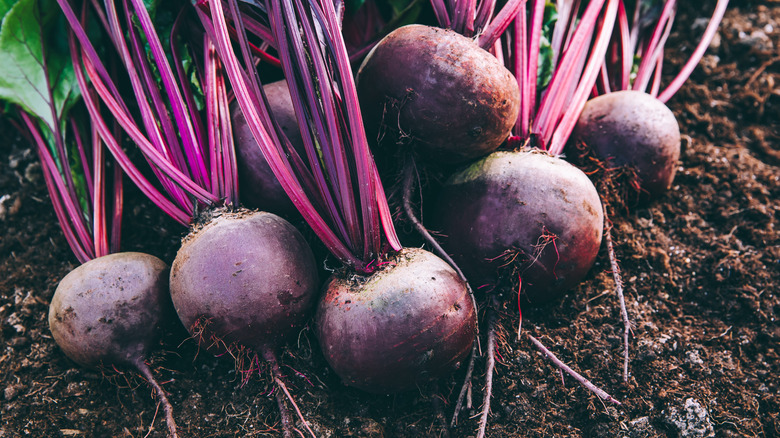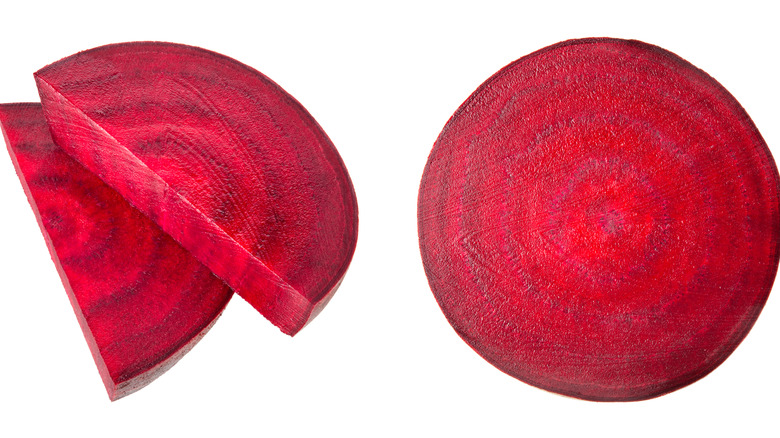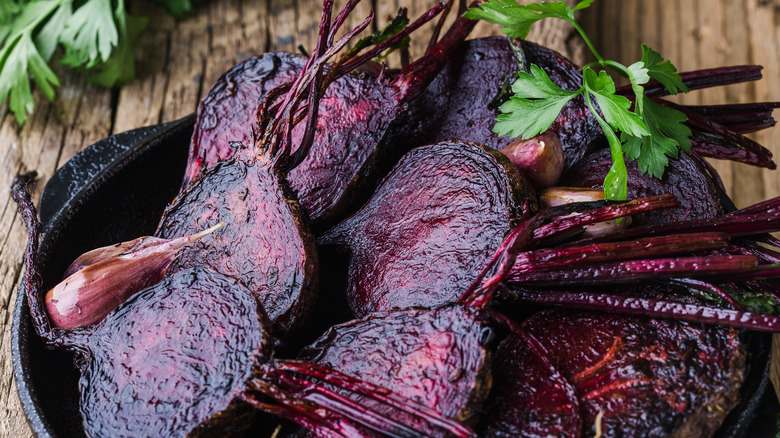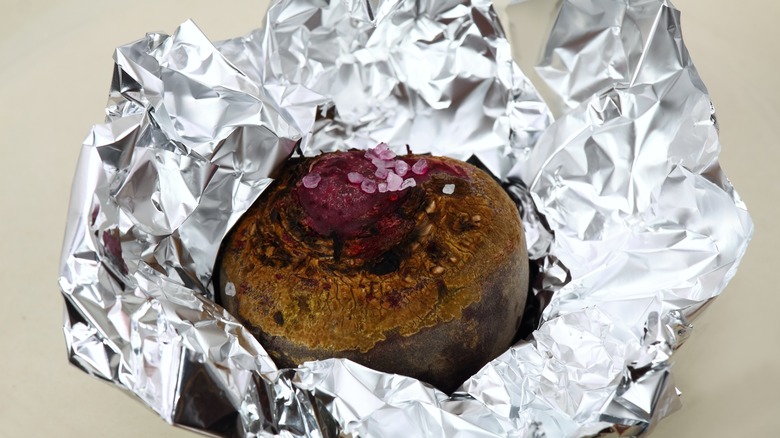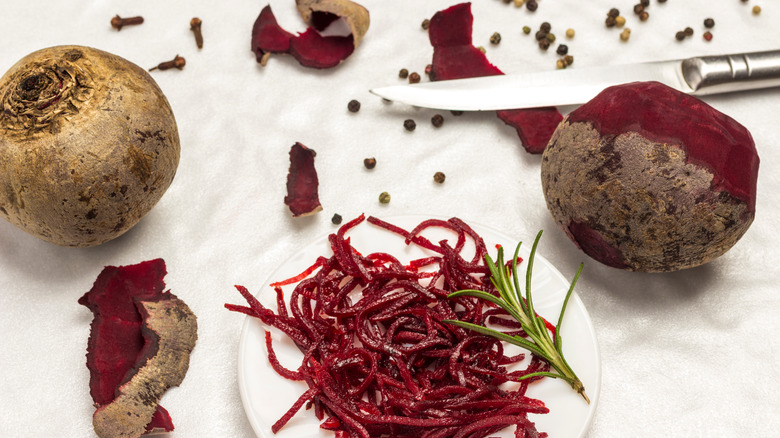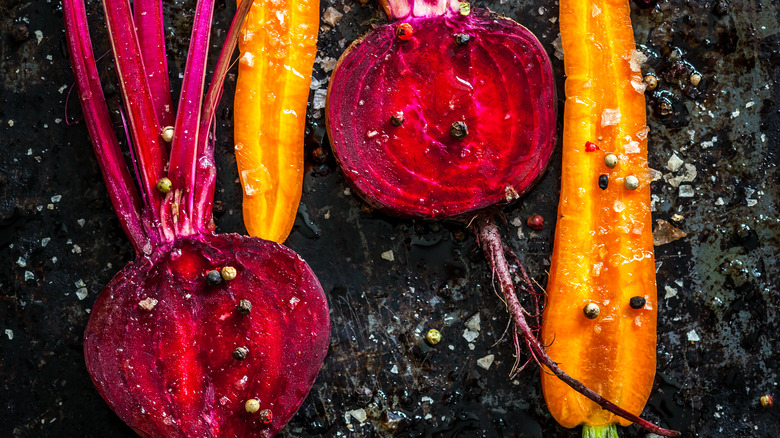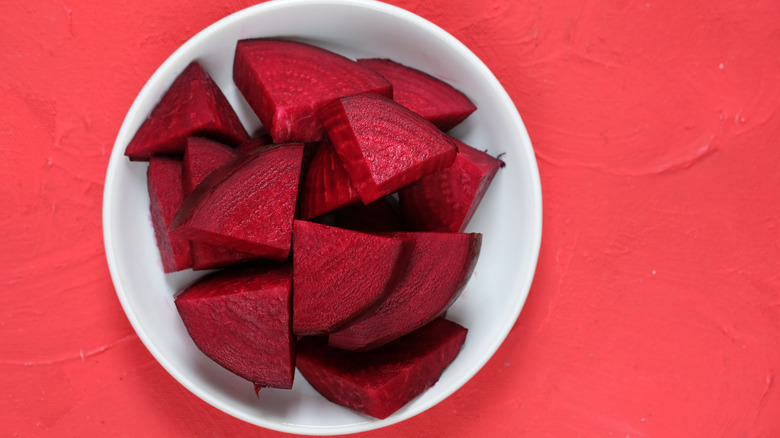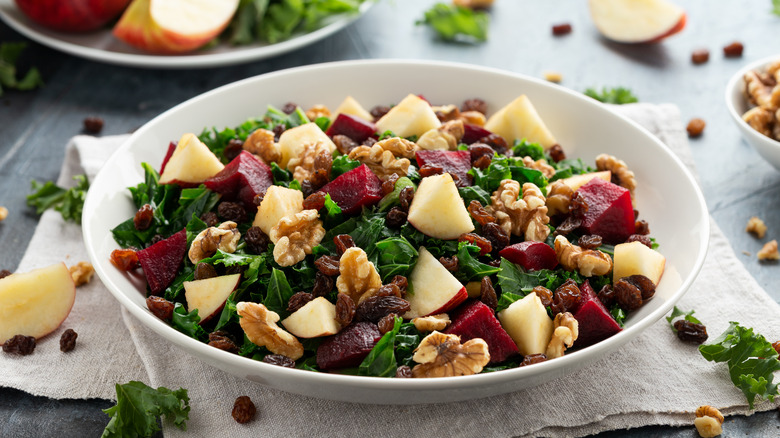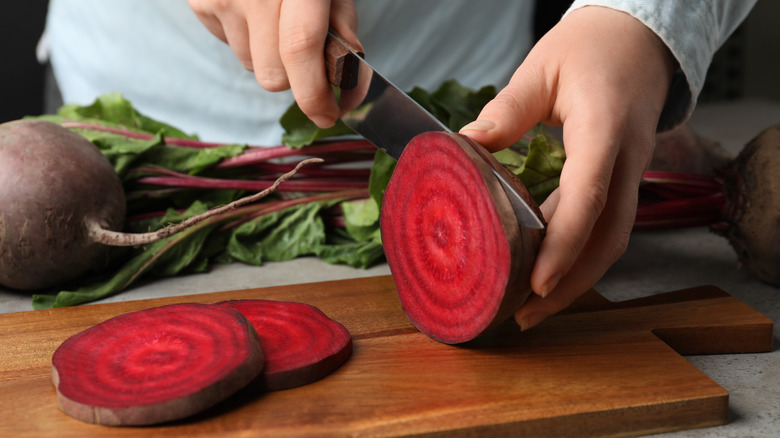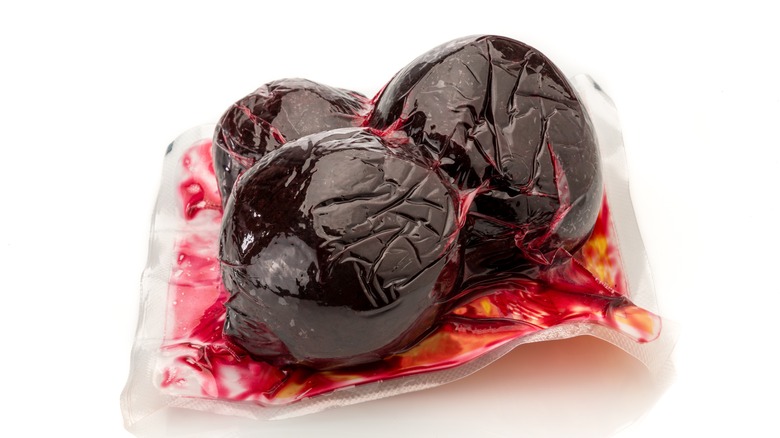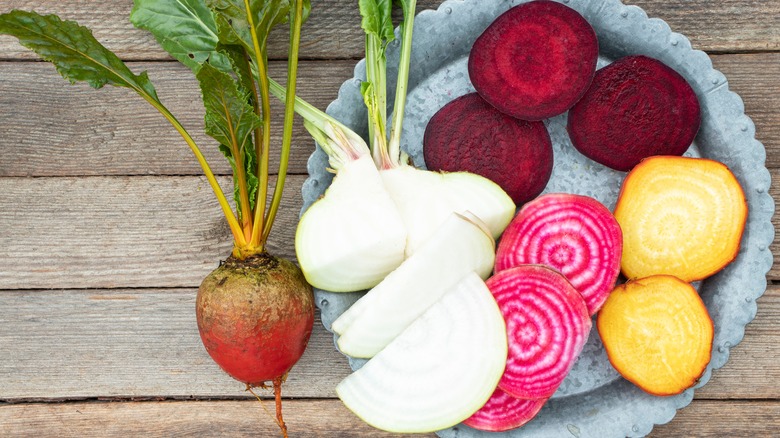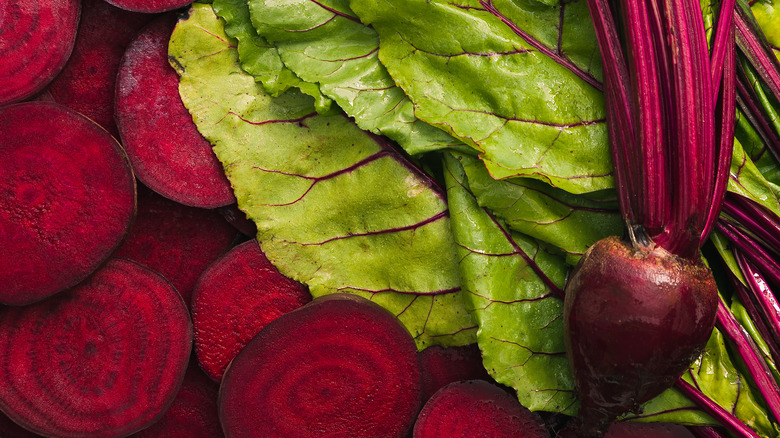What Are Roast Beets And Do You Need To Peel Them Before Eating?
We may receive a commission on purchases made from links.
Much like Brussels sprouts or cauliflower, beets are one of those vegetables that has experienced a major resurgence — let's call it a glow-up — in recent years. From the maligned root veggie of our youth, beets' "tastes like dirt" reputation has grown into an "earthiness" we can all love.
But according to Encyclopedia Britannica, the magenta veggie is only one of four commonly cultivated kinds. Another, Everyday Health explains, is the sugar beet, which first took root in what is now western Poland and has long been used to produce refined sugar.
In fact, the Smithsonian explains, following a German chemist's 18th-century discovery of a manufacturing method that allowed sugar beets to topple the sugarcane monopoly, beet sugar became ever more popular in the 19th century, when Napoleon decreed that the sugar beet be planted widely throughout France in order to combat a lack of sugar due to the British blocking France's trade routes with the Caribbean at the time.
That said, while beet sugar is alive and well in France, when most people refer to beets, they mean garden beets, perfect for use in soups and salads, enjoyed raw, pickled, or roasted. And if you're ready to beef up your beet knowledge, you've come to the right place.
What are beets?
Beets (Beta vulgaris) are a root vegetable belonging to the same family as amaranth, according to Encyclopedia Britannica. It's a biennial plant, and while the leaves of beets are indeed edible, they are primarily grown for their edible taproot, which may vary in shape and size depending upon the time of year and the season, not to mention the individual variety. While the most commonly recognizable beet is a deep magenta, beet varieties come in many colors from yellow to pink, white to candy-striped. Beets can also come in different shapes, like the long crapaudine beet, which looks far more like a gnarled carrot than a globe.
When buying beets, Everyday Health recommends looking for unblemished specimens. The outlet also suggests seeking out medium-sized beets for a tenderer texture — and opt for beets that are all of a similar size so that they cook through evenly.
How do you roast beets?
While there are tons of ways to enjoy beets both cooked and raw, roasted beets consistently emerge as a favorite — and for good reason.
While a number of different varieties of beets exist, the most common are a beautiful ruby red, a color that unfortunately stains your fingers and cutting board as you peel and slice. But if you wrap whole, washed beets in foil, roasting them until tender, you'll effectively steam them from the inside out, rendering the beets tender, juicy, and concentrated in sweet, earthy flavor.
Beets take quite a while to cook through — up to an hour, depending on their size — but luckily, this step can be done in advance. Once the beets are cooked, they can be brought to room temperature or even cooled completely before peeling. (Their skins will slip off easily, but gloves are your best bet if you want to keep from staining your fingers!) After this, they can simply be stored in the fridge until ready to use.
Do you need to roast beets in foil?
Roasting beets in foil is definitely the easiest (and neatest) way to get the job done. Simply wash the beets, trim the beet greens, season (if you like), and wrap in foil before popping the beets in the oven. An hour later, they can be set aside to cool until ready to peel and enjoy!
But despite the ubiquity of this method, it's not your only option. Cooking blog She Loves Biscotti recommends roasting whole beets on a sheet of parchment paper for an even more concentrated flavor (and almost as simple a cleanup), you could also opt to slice unpeeled beets before roasting for caramelized edges and an even shorter cooking time. The way you choose to roast beets at home is ultimately up to you, though if you're planning on eating your beets right away, the slicing method may be your best bet.
Do you need to peel beets?
As a root vegetable, beets grow in the ground, so it's unsurprising that the beets you find in your local shop may well be a touch dirty or sandy. But while many recipes call for peeling beets before cooking them, other experts note that it's not necessary. Cookies and Kate says that with their method of slicing beets before roasting, the skin "just seems to disappear" in the oven.
For some, however, the pleasant earthiness of beets becomes slightly unpalatable when concentrated in the skin. Luckily, you don't need a peeler to rid beets of their skins. (Which is good news if you don't want magenta hands!) This roast beet hack calls for wrapping them in foil and cooking them til tender. Once cooled, trimming their rough ends should be enough for them to slip right out of their skins with ease — no elbow grease required.
What do roasted beets taste like?
Given their use as a sugarcane substitute, it's no surprise that beets have a slight sweetness to them that, like with many other vegetables, only intensifies when roasted in the oven. In addition to their sweet flavor, beets are also known for their earthiness, an aroma that, according to Flavorful Home, has unfortunately long invited comparison with dirt. (Who among us can't remember lodging that complaint with our parents when this veg appeared on the dinner table?)
Roasting, however, may be the secret to getting over any aversion towards beets. When roasted, according to the outlet, beets' sweetness outweighs their earthiness, leaving just a pleasant trace of bitterness to contend with. The resulting vegetable, can even have a touch of a floral note — an apt comparison, given their beautiful colors not dissimilar to those of beautiful wildflowers!
Are roast beets good for you?
In addition to being tasty and beautiful, beets are incredibly good for you, rich in antioxidants. Perhaps the most essential of these are betalains. This powerful antioxidant is found in only a handful of vegetables, and, WebMD explains, has been found to reduce inflammation and even protect against cancer.
Beets are also high in nitrates, which turn to nitric oxide in the body. This, the outlet continues, can help increase blood flow to your muscles and can also help lower blood pressure. Beets are also high in folate, manganese, and vitamins C and A — a veritable superfood!
To these benefits, Healthline adds beets' power in improving digestive health, thanks to their richness in fiber. But a word of warning: Eating too many beets can contribute to a higher risk of kidney stones, due to their high levels of oxalate. And Medical News Today adds that eating beets in large quantities can cause the red pigment to get into your stool and urine — which can mean for surprising trips to the bathroom!
How to cook with roast beets
Once you've roasted your beets, there are loads of ways you can enjoy them. According to Produce Made Simple, beets pair particularly well with herbs like thyme, tarragon, dill, parsley, mint, basil, and coriander, as well as spices like allspice, cumin, cinnamon, pepper, paprika, and caraway seeds. Top roast beets with an herby chimichurri sauce, which will add a touch of brightness to the sweet, earthy vegetable, or season beet hummus with warming spices for a unique play on the Middle Eastern classic, perfect for dipping or spreading on a falafel sandwich for a pop of color.
Beets are also a classic paired with fresh cheeses like goat cheese or feta, as in this simple but delicious beet salad. Walnuts or apple slices make a lovely complementary component. Roast beet slices can also be slipped into sandwiches or simmered in a classic borscht – the ideal warming dish for winter months.
Are roast beets better than boiled or raw?
While roast beets may be one of the most popular ways of enjoying this root vegetable, it's far from the only way to show them off at their very best.
Raw beets are lovely in a beet carpaccio or spiralized for a fun-textured salad. (And according to Livestrong, eating the veggie raw is even healthier than enjoying it cooked, with registered dietitian Whitney Stuart, RDN, CDE telling the outlet that raw beets have a higher antioxidant concentration.) But beets can also be cooked by boiling, frying, or even incorporating into baked goods, where they add sweetness and a touch of color. You can even microwave beets to get them on the table even more quickly.
Pickled beets are a classic, and while it's easy to make them at home, it's even easier to buy them canned — just be aware that they contain added sugar, and many brands use high-fructose corn syrup in their recipes.
Where to buy roasted beets
Beets are fairly omnipresent at grocery stores and farmer's markets across the U.S. Look for dark red beets with fresh-looking stems (and fresh-looking greens, if they're still attached), and be sure to buy beets that are unblemished and of similar size so that they cook evenly.
If you can't be bothered cooking beets at home, you can actually purchase cooked beets at some supermarkets like Trader Joe's. TJ's sells steamed, peeled beets in the refrigerator section, and you can also buy vacuum-sealed bags of pre-cooked beets on Amazon. Beets are also sold canned, usually in slices. Pickled beets were for a long time the most popular shelf-stable option, though this product does contain a fair amount of sugar, somewhat negating all of those lovely health benefits. Other brands season beets relatively simply, with just a pinch of salt, making them ready to use in whatever recipe you choose.
What's the difference between red beets and other colors?
When you think of beets, the most common image you're likely to conjure is that of a ruby red root vegetable. But in reality, beets are available in a wide range of colors from white to golden to candy-striped Chioggia.
According to Plantura, yellow beets are milder and sweeter than red beets, and seeing as they also don't stain your hands, they're a great place to begin for beet amateurs.
Chioggia beets, meanwhile, boast beautiful red-and-white stripes. They're particularly lovely when sliced into rounds and served as a carpaccio, so that their distinctive colors really shine. When cooked, according to Specialty Produce, their gorgeous color has a tendency to fade away. If you do decide to boil Chioggia beets, Parade recommends adding a splash of lemon juice or white vinegar to the water to preserve their color as much as possible.
What to do with beet greens
Beets can be sold with or without their greens attached, and if you like sautéed Swiss chard, you'll definitely want to go with the former. Beet greens aren't just edible: According to Healthline, they're incredibly nutritious, rich in potassium, calcium, riboflavin, fiber, and vitamins A and K, not to mention loads of antioxidants, just like the root portion of the plant. Plus, they're delicious.
Beet greens are delicious when simply sautéed, as in this recipe for beet greens sautéed with garlic and lemon. They make a great stand-in for kale in a white bean soup, or you could pair them with kielbasa as a substitute for turnip greens in this hearty soup recipe. Fans of creamed spinach will love using beet greens in place of chard when making creamed greens. Young beet greens can even add a pop of color to your favorite salads.
